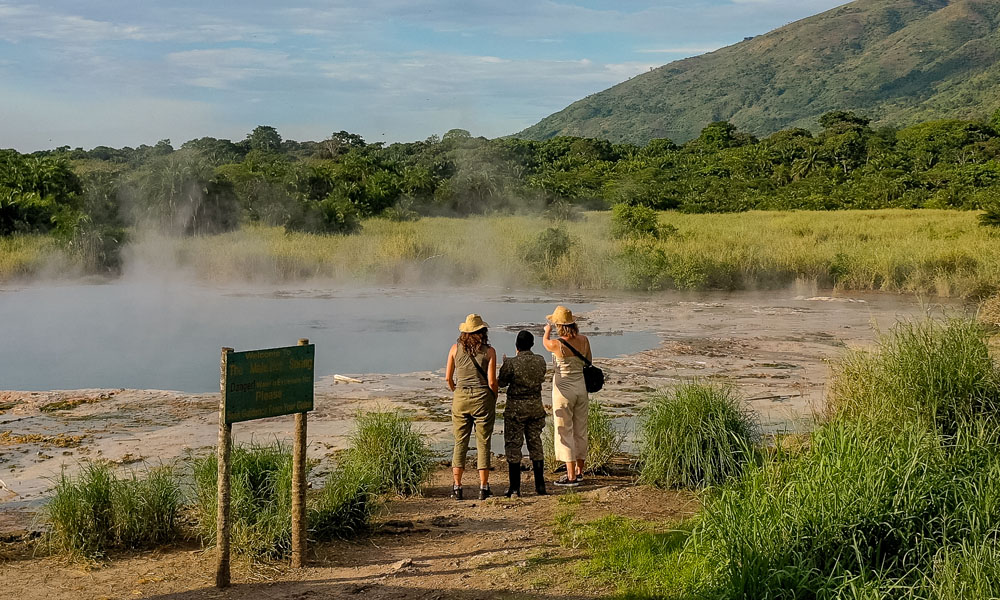Situated in a secluded area of the Bundibugyo District in southwest Uganda, Semuliki National Park is the newest of Uganda’s national parks. It was formally formed in 1993 and is situated in Bwamba Sub County. The 226 km² Semuliki National Park is located between 670 and 760 metres above sea level. Semuliki National Park is located in the western arm of the Albertine Rift Valley, cutting across the Semliki Valley and western of the Mountain Rwenzori. The Ituri forest, which originates in the eastern sections of Congo and spreads across the Congo Basin, makes up the majority of the park. The sole remaining area of authentic lowland tropical forest in East Africa is found at Semuliki Valley National Park.

Activities in Semuliki Valley National Park
Nature Walk
The Semuliki jungle life is especially amazing for birdwatchers and people who want to witness different plant and primate species and butterflies. The two-hour treks through the rainforest, which is home to palm trees and muddy terrain, usually start at Sempaya Gate. They conclude at the Hot Springs. Visitors can see chimpanzees, blue monkeys, red tail monkeys, and mangabeys on the walk. They can also see a variety of mammals, including forest buffaloes, pygmy hippos, elephants, leopards, Sitatunga, Uganda Kobs, and other species. Along with bird species, you may see Great Blue and Ross’s Turacos, Black-casqued Wattled Horbills, Red-rumped Tinkerbirds, Palm nut Vultures, Hornbills, plus Honey guides and a variety of vibrant butterflies when you go on a nature walk.
Local Community Walks
Four notable ethnic groups have left the Semuliki National Park: the Bwamba famers, who live at the foot of Mount Rwenzori; the Bakonjo, who cultivate on the slopes of the mountain; the Bantu, who live on open plains; and the Batwa pygmies, who hunt and gather fruit in the forest. You can see the dances, ways of life, and customs of the nearby pygmy village near the Sempaya Gate by going on a community tour. You can also shop for souvenirs there.
Visit the Sempaya hot springs
The most popular attraction in Semuliki National area is the Sempaya Hot Springs, which every visitor to the area must experience. There are two hot springs: Bitende, a male hot spring with a circumference of roughly 12 metres, and Nyasimbi, a female hot spring with a boiling geyser that shoots steam and hot water up to a height of about 2 metres. The Sempaya hot springs are home to a number of activities such as cooing (eggs), cultural traditions, photography, and teaching. The water can reach a boiling point of 100 degrees Celsius.
Game Drives
A game drive will take you to the Toro Semuliki Wildlife Reserve, which features three well maintained wildlife trails crisscrossing the Savannah plains. Through these trails, visitors can get up close and personal with over 60 different mammal species that call the park home, including the rarely seen smaller forest and larger savannah elephants, waterbucks, buffaloes, warthogs, rare bush babies, Uganda Kobs, and, with luck, leopards and pygmy hippos. Game drives throughout the day and at night are available at this park.
Sport Fishing
One of the most exciting river activities is sport fishing on the Semuliki, where the most common fish species caught are tilapia, lung fish, star fish, and other species. It is strongly advised that you bring your fishing equipment, as the most common methods utilised here are nets, spears, and many other native tools.
Boat excursions on river Semuliki
Semuliki River boat trips are rewarding with an abundance of wildlife and beautiful landscapes. A number of bird species and hippos can be seen during the trip. Typically, bird watching occurs early in the morning when people are looking for shoebills and other aquatic animals. You may fish on the Semuliki River while on your boat excursions.
Bird Watching
One of the things that draws visitors to Semuliki National Park the most is bird watching. There are various areas within Semuliki National Park that are ideal for birdwatchers, including the Ituri Forest, the Sempaya Hot Springs, and the River Semuliki. These areas have drawn over 445 different species of birds, including forest birds, wet land birds, water birds, Albertan birds, and migratory birds that typically arrive during the rainy seasons of September to December and March to May. Many bird species can be found in the park, such as the Black-casqued Wattled Horbill, the Red-rumped Tinkerbird, the African Piculet, the Yellow-throated Nicator, the White-throated Blue Swallow, Leaf-love, the Swamp Palm Bulbul, Maxwell’s Black Weaver, the Red-bellied Malimbe, the Blue-billed Malimbe, the Yellow-throated Cuckoo, the Piping Hornbill, Black Dwarf Hornbill, Great Blue and Ross’s Turacos, and the Red-throated Wattled Horbill.
Best time to visit Semuliki National Park
The greatest time to visit Semuliki National Park is any time of year, however the months of December through February and June through mid-September are considered to be the dry season since they offer the best hiking conditions. For bird enthusiasts, the rainy season is the ideal time to visit the park since it offers an abundance of food and coincides with the migratory bird species’ migration, which occurs from March to June and September to December. While the park experiences more challenging conditions during the rainy season, which occasionally renders the roads nearly impassable, there are very few opportunities for game viewing drives.
